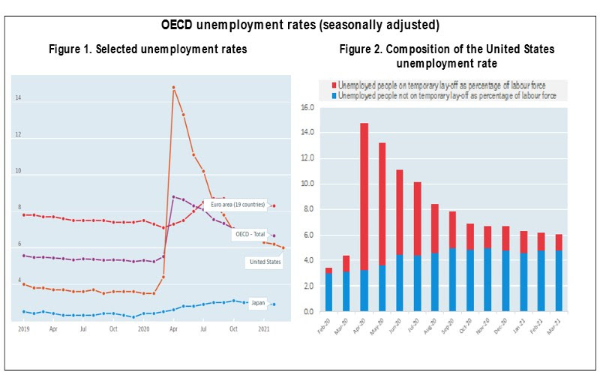Marginal Fall In OECD Unemployment Rate In February 2021, To 6.7%, 1.4 Percentage Points Above Its Pre-pandemic Level
The OECD area unemployment rate declined in February 2021, to 6.7% (from 6.8% in January), remaining 1.4 percentage points above the level observed in February 2020, before the COVID-19 pandemic hit the labour market.[1]
In February 2021, the unemployment rate was stable in the euro area, at 8.3% (1.0 percentage point above its pre-pandemic level). Latvia, with an increase of 0.2 percentage point (to 8.7%) and Slovenia with a decrease of 0.2 percentage point (to 4.9%) represented the largest changes in this area, while little movement was observed in other countries.
In the United States, the unemployment rate fell marginally in February 2021 (to 6.2%, from 6.3% in January), along with a decline in the number of people on temporary lay-off, while in Canada it decreased by 1.2 percentage points, to 8.2%. More recent data show that in March, the unemployment rate declined further in the United States (by 0.2 percentage point, to 6.0%) and Canada (by 0.7 percentage point, to 7.5%). In February 2021, among other countries, the unemployment rate for Australia (down by 0.5 percentage point, to 5.8%) recorded one of the largest declines. By contrast, the unemployment rate increased by 0.5 percentage point in Israel (to 5.1%) and was stable in Japan (at 2.9%) and Mexico (at 4.5%).
The OECD youth unemployment rate (people aged 15 to 24) decreased to 13.7% in February 2021, from 14.0% in January.
More generally, it should be noted that unemployment statistics do not account for the full amount of labour market slack due to Covid-19, as some non-employed people may be classified as “out of the labour force”, because, due to the pandemic, they are either not able to actively look for a job or are not available to work.[2]
See the full release.
See the tables and charts in Excel.

Visit the interactive OECD Data Portal to explore these data further


 World Vision: 3.5 Million Displaced Following Myanmar Earthquake And Ongoing Internal Conflict
World Vision: 3.5 Million Displaced Following Myanmar Earthquake And Ongoing Internal Conflict World Butchers Challenge: World’s Top Butchers From 14 Nations Go Knife-to-Knife In Paris
World Butchers Challenge: World’s Top Butchers From 14 Nations Go Knife-to-Knife In Paris Save The Children: ‘It Was Terrifying’ - Children Prepare To Spend Myanmar New Year Festival In Shelters Following Earthquake
Save The Children: ‘It Was Terrifying’ - Children Prepare To Spend Myanmar New Year Festival In Shelters Following Earthquake Global Forest Coalition: Global NGOs Call On International Maritime Org To Reject Biofuels And Commit To Truly Clean Energy
Global Forest Coalition: Global NGOs Call On International Maritime Org To Reject Biofuels And Commit To Truly Clean Energy Australian Catholic University: Principals Navigate Growing Challenges As Anxiety, Depression Increase And Violence, Workloads Intensify
Australian Catholic University: Principals Navigate Growing Challenges As Anxiety, Depression Increase And Violence, Workloads Intensify SNAP: Survivors Deliver Vos Estis Lux Mundi Complaints Against Six Cardinals To Vatican Secretary Of State Parolin
SNAP: Survivors Deliver Vos Estis Lux Mundi Complaints Against Six Cardinals To Vatican Secretary Of State Parolin